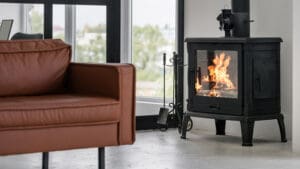Homeowners are looking for ways to heat their homes that are both efficient and good for the planet. Wood-burning stoves are becoming a popular choice for keeping homes warm in a sustainable way. They offer advanced technology that balances comfort with environmental care.
Wood-burning stoves are more than just a way to heat your home. They are a smart way to control your home’s climate. These systems are designed to be energy-efficient, providing warmth without harming the environment. They use the latest technology to produce more heat and reduce carbon emissions.
Learning how to use wood-burning stoves properly is key to a cozy, safe, and green home. This guide will cover everything you need to know about using these stoves in your home.
Understanding Modern Wood-Burning Stove Technologies
Wood-burning stoves have seen big changes in recent years. Today’s stoves are much more efficient and better for the environment than old ones. If you’re looking into getting a log burner in the UK, you’ll find many new options. These options are great for heating your home and are also good for the planet.
Modern stoves use new technologies to cut down on emissions. They have special systems for taking in air and burning fuel more efficiently. This means less waste, lower fuel bills, and a smaller environmental footprint for homes in the UK.
New features include ceramic-lined fireboxes and smart controls. These help spread heat better, burn fuel more efficiently, and let you set the exact temperature. When looking at log burner installation costs in the UK, you’ll find that many modern, high-tech stoves not only heat your home efficiently but also offer excellent long-term value.
Materials used in stoves have also improved. Now, they use strong alloys and ceramics that last longer and keep heat better. Stoves also look good in your home, adding to its style. When looking at different stoves, think about these new technologies and how they affect costs.
Essential Safety Regulations and Compliance Standards
Understanding safety rules for wood-burning stoves in the UK is key. These rules aim to keep homeowners safe and ensure warm homes. They set clear guidelines for using wood-burning stoves to avoid risks.
Important standards cover several areas. Stove installation must follow strict building codes. This includes ventilation, distance from flammable materials, and chimney details. Homeowners must also check if their stove meets UK safety standards, like emissions and structural tests.
Knowing these rules helps avoid dangers. Using wood-burning stoves right in the UK means regular checks, approved fuels, and safety distances. Experts can help meet these safety needs.
Manufacturers must follow strict performance rules. Look for stoves with safety marks from bodies like HETAS or CE. These marks show the stove is safe and efficient.
Homeowners should focus on safety by knowing the latest rules. Keeping your stove in good shape, getting it installed right, and following standards are vital. This ensures safe and responsible use of wood-burning stoves in the UK.
Proper Use of Wood-Burning Stoves: A Comprehensive Guide
Learning to use a wood-burning stove well takes focus and safety steps. First, make sure your stove is installed right and follows local rules. This is the start of a good guide to using log burner vents.
Before you light your stove, get ready. Choose dry, seasoned wood to get more heat and less creosote. The right airflow is key, so open the vents wide at first. Then, adjust them to keep the fire burning well.
Good ventilation is vital for your stove’s performance. Keep the vents clean and clear to avoid smoke and ensure air flows well. Regular checks for blockages or damage are part of keeping your stove safe and efficient.
Controlling the stove’s temperature is also important. Use a thermometer to check the heat and avoid overheating. Aim for a temperature between 300-500 degrees Fahrenheit for best heat and less pollution.
Always put safety first. Have a fire extinguisher ready, install carbon monoxide detectors, and keep the area around the stove clear. By following these tips, you’ll enjoy a warm and safe home with your wood-burning stove.
Selecting the Right Firewood: Types and Quality Indicators
Choosing the right firewood is key to your wood-burning stove’s performance. The best firewood logs to burn chart helps you pick the best wood for heat and efficiency. Hardwoods like oak, hickory, and maple are top choices for home heating.
Moisture content is very important when picking firewood. Seasoned wood with less than 20% moisture burns cleaner and hotter. Softwoods like pine burn fast but don’t last long. Hardwoods give longer, steadier warmth.
Look for wood that’s grayish in color, sounds hollow when knocked, and feels light. This means it’s well-seasoned. Keeping firewood in a dry, well-ventilated spot for 6-12 months ensures it burns well.
Different woods burn in unique ways. Oak gives intense, long-lasting heat with little smoke. Maple burns cleanly with steady flames. Hickory offers high heat and a nice smell. Knowing these differences helps you choose the best firewood for your needs.
Installation Requirements and Cost Considerations
Getting a log burner installed in the UK needs careful planning and a budget. Costs range from £1,500 to £5,000, depending on several factors. Homeowners should think about chimney condition, stove type, and local rules when budgeting.
Important costs include structural changes, chimney liners, and the installer’s work. Older homes might need extra work, raising costs. Where you place the stove and ventilation needs also affect the price.
Certified installers are key for safe and legal log burner setups in the UK. Prices vary, with simple installs starting at £1,500 and complex ones up to £5,000. Getting quotes from different pros helps understand your costs.
Local building rules also play a big part in costs. Some places need special permits or checks, adding to the bill. A pro install ensures your stove is safe, meets rules, and works well.
To save money, prepare the site, check the chimney, and pick the right stove for your home. Talking to installers helps set a realistic budget for your stove project.
Maintenance and Cleaning Protocols for Long-Term Performance
Using wood-burning stoves in the UK needs regular upkeep for best performance and safety. Cleaning and checking your stove often helps keep it running well and lasts longer.
Start daily care by removing ash gently after each burn. Use a metal bucket for ash and wait until it cools down before throwing it away. Also, clean the glass with a special cleaner made for wood stoves. Don’t use harsh cleaners that could scratch it.
For weekly upkeep, do a deeper check on your stove. Look at the door seals for wear or damage. Also, check the flue and chimney for blockages or soot. Clean the firebox and remove any debris to keep air flowing well.
Seasonal upkeep is key for your stove’s health. Before heating starts, get a professional to sweep your chimney. This ensures it’s clean and finds any problems. Also, check the stove’s parts like baffle plates and fire bricks. Replace any that are worn out to keep your stove efficient.
Following these upkeep steps helps UK homeowners get the most out of their wood-burning stoves. Regular care stops problems and keeps your stove working its best all winter.
Maximizing Heating Efficiency Through Proper Ventilation
Knowing how to use stove vents right is key for heating your home well and safely. Good ventilation lets wood-burning stoves work their best. This cuts down on fuel use and boosts heat output. For more efficient burning, it helps to follow a guide to proper log burner vent use, which focuses on managing airflow effectively throughout the heating process.
Stove vents control how much oxygen gets in, which affects how well the stove burns. To use vents for better heating, start by opening the air control fully when lighting the stove. This creates a strong, hot fire that burns well and gives off lots of heat.
Once the fire is steady, start to cut down on air intake to keep the burn steady. Modern stoves have air controls that let you adjust ventilation. Look for a bright, blue-white flame to know you’re burning efficiently. A smoky, lazy flame means you need more airflow.
Remember, safety is always first when working with stove vents. Make sure there’s enough space around the stove, keep vents clear, and have carbon monoxide detectors nearby. Regular checks on your vents keep your stove safe and efficient.
Learning to control stove vents well makes your home warmer and more energy-efficient. It also cuts down on costs and is better for the environment.
Sustainable Practices and Environmental Considerations
Wood-burning stoves are a green heating option if used wisely. Knowing the firewood burn quality chart helps make choices that cut down on carbon emissions. This protects our planet.
Choosing wood from sustainable sources is key. Look for wood from local forests that are managed well. This ensures trees are replanted and ecosystems stay healthy. Wood from certified sustainable forests is best, as it helps the environment and supports tree growth.
The firewood burn quality chart shows important facts about wood choice. Hardwoods like oak and maple burn better, making less smoke and more heat. Wood that’s dry and seasoned burns cleaner, cutting down on harmful emissions and improving stove efficiency.
Being energy-efficient is vital for the environment. Today’s wood stoves use new tech to burn wood better, wasting less and heating more. Keeping your stove clean and following the maker’s advice helps lower carbon emissions.
Smart burning habits also help the environment. Use dry, seasoned wood and keep air flowing right. Avoid burning wood that’s been treated or painted, as it releases bad stuff into the air.
Conclusion
Learning how to use wood-burning stoves in the UK is key to good home heating. We’ve covered important steps to make stoves efficient and eco-friendly. This starts with knowing the tech, safety rules, and green practices.
Using wood-burning stoves right is more than picking the right stove. It’s about choosing good firewood, installing it right, and keeping it up. By learning these skills, you can heat your home better and help the planet.
Wood-burning stove care is all about safety, efficiency, and being green. By doing this, you make your home cozy and cut down on carbon emissions. Every piece of wood and maintenance check helps make your heating more eco-friendly.
As heating tech gets better, knowing how to use wood stoves in the UK is even more important. By following these tips, you’ll make your home cozier and help the planet.
Read more:
Wood-Burning Stove Best Practices for 2025/2026: How to Heat Your Home Safely and Sustainably















